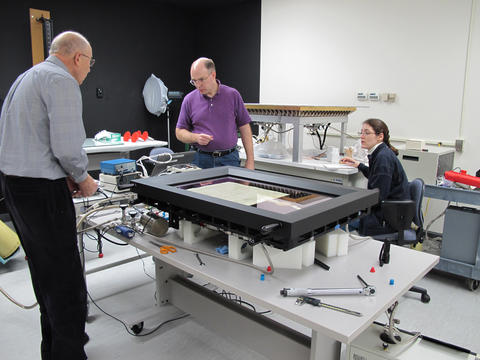
The Magna Carta rests in its argon-filled NIST encasement at the Archives Conservation lab.
You often hear about the Framers of the Constitution, but not so much the framers of the Magna Carta. They work for the National Institute of Standards and Technology (NIST).
Not the authors, of course; they've been dead 700 years. But a NIST engineering team, at the behest of the National Archives, designed and built a state-of-the-art encasement and transport cart to protect the Archive's prized copy of the 1297 Magna Carta. Their work—and the freshly conserved Magna Carta—were on display Feb. 2, 2012, at a special "behind-the-scenes" showing at the National Archives Conservation Lab. The enclosure is designed to visually enhance the parchment document while maintaining the interior environment so it does not degrade the document, which is the underpinning to Western Civilization and U.S. law.
The encasement is basically a controlled environment, explained NIST Project Engineer Jay Brandenburg, who regularly does similar tasks to isolate sensitive lab equipment.
The first Magna Carta was signed in 1215 by King John of England. He was forced by an assembly of barons to put in writing, for the first time, the traditional rights and liberties of the country's free persons. After another confrontation with barons, Edward I not only reissued the Magna Carta in 1297, but for the first time, it was entered into the official Statute Rolls of England and became the foundation of English law.
The owner of this copy of the Magna Carta, David M. Rubinstein, loaned the document to the National Archives and paid for its restoration and encasement.
While the Archives refurbished the parchment, NIST engineers and crafts people built a platform to hold the Magna Carta, the large encasement it sits in and a heavy-duty cart.
NIST worked from a three-dimensional laser scan of the document to support it on the platform and to create a nest to hold the original wax seal with Edward I's likeness, which is attached to the Magna Carta by a frail parchment ribbon.
The platform was created from a single 6-inch thick block of aluminum to minimize the number of joints or spots that could cause leaks in the encasement, explained Brandenburg. About 90 percent of the block was cut away with a computer-controlled milling machine based on the three-dimensional image to create the perfect fit.
The end result is an enclosure about 41 inches wide by 28 inches long and 6 inches deep. It weighs 225 pounds. The encasement cover is made of a special laminated glass with antireflective coatings to ensure maximum visibility of the document while protecting it. The encasement is sealed with close-fitting bolts that hold the frame against double O-rings that create the encasement seal. The case was filled with argon gas and will be monitored to avoid as much oxidation damage as possible.
The enclosure will likely never be seen in its entirety again. By mid-February it will be placed inside the new interactive display in the West Rotunda Gallery of the U.S. National Archives Building in Washington, D.C. There, alongside three other documents for which NIST built similar enclosures—the Declaration of Independence, the Constitution and the Bill of Rights—it will be on display for the 1 million visitors that pass through the Archives each year.
Learn more about previous NIST work on document enclosures.

